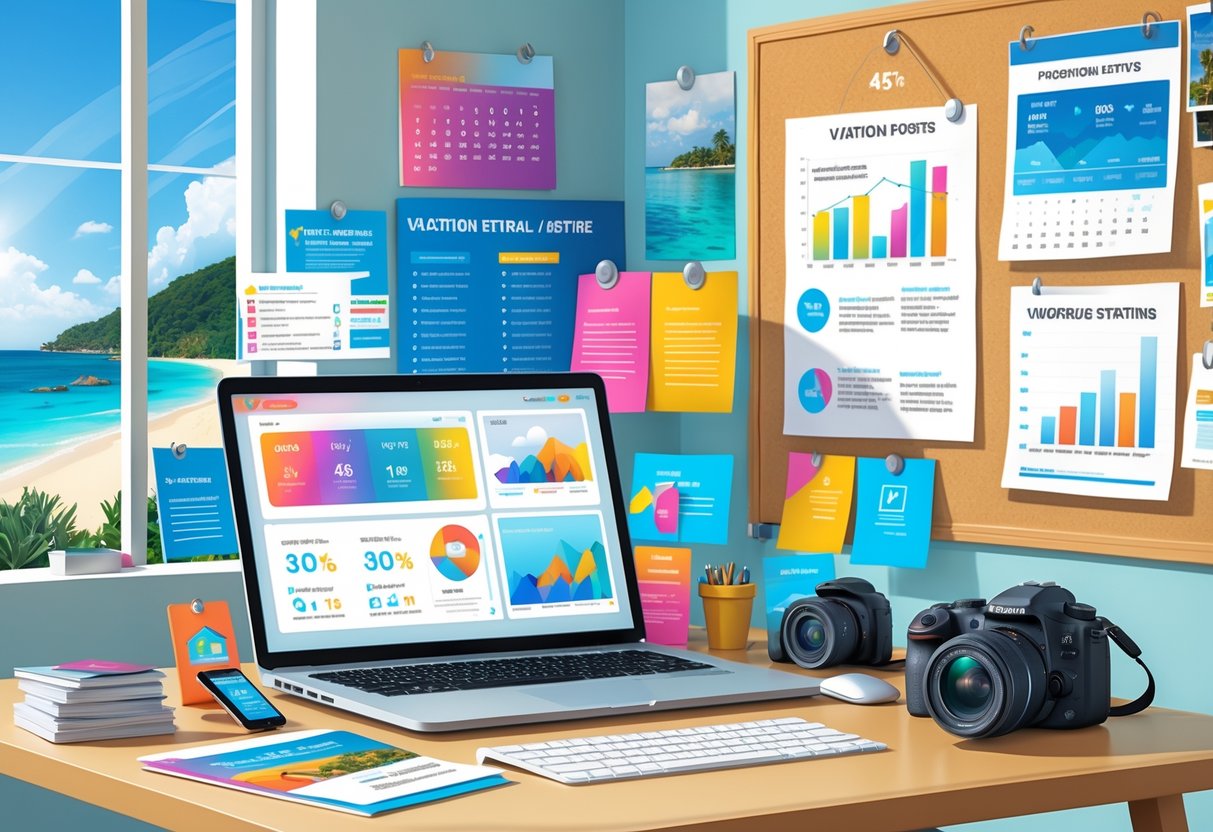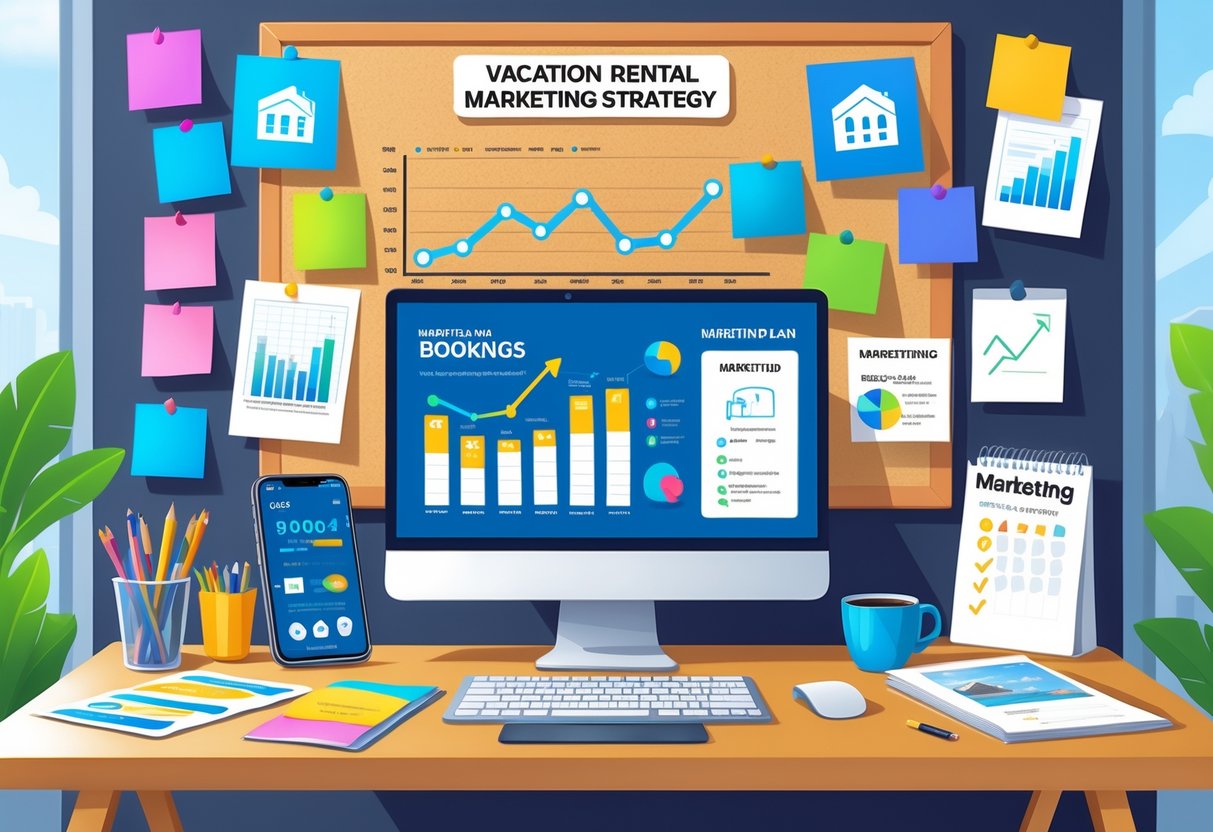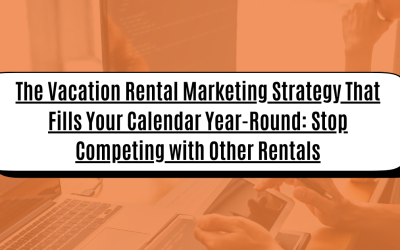The vacation rental market just keeps getting more competitive. If you want your property to stand out and stay booked, you can’t skip smart marketing.
Successful vacation rental marketing means showing up everywhere: optimize your listings, build direct booking strategies, and focus on guest relationships if you want to see real, steady revenue. Many property owners honestly feel overwhelmed by all the booking platforms, pricing tricks, and digital marketing options out there.

Just listing your place on Airbnb or Booking.com isn’t enough. You need to optimize your listing content with sharp descriptions and great photos, build your own website for commission-free bookings, and use social media to reach the right people.
The best hosts also double down on guest experience and reviews. Those glowing reviews? They’re marketing gold.
There’s a whole world of tactics out there—SEO, email marketing, local partnerships, pricing tweaks. The trick is figuring out what fits your property and your guests, then actually sticking with it.
Key Takeaways
- Don’t rely on just one platform—spread out across multiple channels to get seen and reduce risk.
- Use killer photos and dialed-in listings to turn lookers into bookers.
- Build direct relationships through your website, email, and personal touches so guests come back.
Crafting a Winning Vacation Rental Marketing Strategy

If you want a real shot at success, you need a strategy. That means setting actual goals, knowing what your guests want, and having a plan to connect with the right travelers.
Start by figuring out measurable objectives and knowing who you’re trying to attract.
Defining Your Marketing Goals
Before you do anything else, set clear and specific goals. Otherwise, it’s just guesswork.
Revenue targets are usually the main thing. Set monthly booking numbers, average nightly rates, and occupancy goals that make sense for your property and your market.
Primary marketing goals usually look like:
- Getting more direct bookings (pick a percentage)
- Relying less on third-party platforms
- Raising guest satisfaction scores
- Attracting new types of guests
Brand awareness matters, too. Keep an eye on website traffic, social followers, and email signups to see if your reach is growing.
Short-term goals might focus on filling up for summer, while long-term ones are about building loyalty and word-of-mouth.
Identifying Target Audience and Guest Personas
You can’t market to everyone. The best vacation rental marketing strategies are built for specific types of guests.
Guest personas help you picture your ideal customer. Each one should cover basics like age, travel style, booking habits, and what really matters to them.
Some common guest personas:
- Business travelers who want longer stays
- Families who need space (and maybe a pool)
- Couples on romantic escapes
- Groups celebrating or reuniting
Dig into past booking data, send out surveys, and read competitor reviews to learn what your guests actually care about.
Budgets vary a lot. Business folks care about convenience, families hunt for value, and millennials might splurge last minute.
Booking patterns change by group, too. Millennials might book late on their phones, while older guests plan ahead on a laptop.
Building a Comprehensive Marketing Plan
A vacation rental marketing plan ties everything together. Match your tactics to your goals and guest personas.
Choose channels based on where your guests are searching. Airbnb, Vrbo, Booking.com—sure, but don’t ignore niche sites or direct booking strategies.
Use a content calendar to plan your year. Push premium pricing and availability in peak season, and highlight deals or local events in the off-season.
Key parts of a good plan:
- Monthly marketing budgets
- Schedules for new photos and descriptions
- Social media posting plans
- Email campaign timelines
Keep tabs on how things are going. Track conversion rates, cost per booking, and ROI so you can tweak your approach.
Balance your budget: spread it between ads, content, and platform fees. Most successful owners spend around 5-15% of their revenue on marketing.
Maximizing Exposure on Major and Niche Listing Platforms

If you want people to find your place, get it on multiple platforms and make sure each listing is optimized for that site’s quirks. The best results come from mixing big-name sites with smaller, more targeted ones.
Optimizing Listings on Airbnb, Vrbo, and Booking.com
Every platform has its own secret sauce. Vacation rental marketing strategies start with learning what each site wants.
Airbnb likes hosts who respond quickly and accept most bookings. Fill out your profile, use professional photos, and write detailed descriptions.
Vrbo leans toward family-friendly places and longer stays. Spell out your amenities and house rules.
Booking.com cares about guest satisfaction and conversion rates. Flexible cancellation? That’ll bump you up.
To optimize your listings:
- Use keywords in your titles and descriptions
- Keep your calendar up to date everywhere
- Respond to inquiries within an hour
- Collect reviews—lots of them
- Update your photos for each season
Leveraging Online Travel Agencies and Alternative Channels
There’s more out there than just Airbnb and Vrbo. Expedia can plug your listing into their huge network.
Smaller sites like Whimstay or Savvy go after specific groups. Less competition there, and sometimes better conversion if you fit their crowd.
Other channels to try:
- Direct booking websites – skip the fees
- Social media – Instagram and Facebook can drive bookings directly
- Email marketing – reach out to past guests
- Local tourism boards – many have directories
Spread your bookings across channels, but keep your pricing and availability consistent.
Benefits of Local and Niche Vacation Rental Sites
Local and niche sites attract travelers who know what they want. Plus, they often charge less in commissions.
Local tourism websites connect you to guests who already plan to visit your area. Many regions have official accommodation directories.
Niche platforms cover:
- Pet-friendly stays
- Luxury rentals
- Eco-friendly properties
- Corporate travel
These sites bring in guests who already know what they’re after. Less competition, higher-quality leads, and often a better booking rate.
Driving Direct Bookings Through Your Own Website
Want to keep more of your money and connect with guests? Build your own site. Skip platform fees and make it easy for guests to book directly.
It’s all about a solid site, a reliable booking system, and making it super easy for visitors to turn into guests.
Building an Effective Vacation Rental Website
Start with the basics. You can use a DIY builder or hire someone, but make sure your site covers the essentials.
Must-have features:
- Multiple payment options—think credit cards, PayPal, bank transfers
- Calendar sync with all your platforms to avoid double bookings
- Mobile-friendly design—most people book on their phones
- High-quality photo galleries
Professional direct booking sites should automate guest messaging. Booking confirmations, check-in details, follow-ups—they should all go out on their own.
If you’ve got several properties, create separate landing pages for each. That way, your site can grow with your business.
Build trust with:
- Real guest reviews
- Digital guidebooks with local tips
- Clear cancellation policies
- Secure payment badges
Keep your website fast and easy to navigate. If it drags, guests will bail in seconds.
Integrating Booking Engines and Website Builders
Your booking engine is the heart of your site. Lodgify is popular—it comes with website tools and booking management built in.
Look for booking engines with:
| Feature | Importance | Benefit |
|---|---|---|
| Real-time availability | Critical | No double bookings |
| Instant confirmations | High | Guests trust you more |
| Multi-currency support | Medium | Attracts guests from anywhere |
| Damage deposit handling | High | Protects you |
Rental-focused website builders offer stuff like availability calendars, rate management, and guest messaging—stuff generic platforms skip.
Make sure your booking engine syncs with Airbnb, Vrbo, etc. That way, your calendar always stays updated.
Integration checklist:
- API connections to booking sites
- Works with your payment processor
- Connects to email marketing tools
- Tracks analytics
Don’t forget to stress-test your system during busy seasons.
Conversion Rate Optimization for Increased Bookings
Turning visitors into guests is all about the details. Even small tweaks can mean more bookings.
Boost conversions with:
- Transparent pricing—no hidden fees
- Booking buttons that stand out on every page
- Scarcity cues (“Only 2 nights left this month!”)
- Social proof—show off those guest testimonials
Direct booking strategies work best when you highlight what makes your place special, not just the price.
Try these optimization tricks:
- Test different button colors and texts
- Simplify the checkout—fewer steps, fewer drop-offs
- Add urgency (“Last chance for summer dates!”)
- Offer perks for booking direct (late checkout, free Wi-Fi)
Keep the booking process short and sweet. Every extra field is a chance to lose a guest.
Track your results:
- Watch bounce rates on property pages
- Find out where people abandon their bookings
- Measure time from inquiry to booking
- Analyze which traffic sources convert best
Direct bookings don’t just happen. Keep testing, tweaking, and learning from your data.
Enhancing Visibility with SEO and Digital Marketing
If you want your property to pop up when travelers search, you need good SEO and smart digital ads. Use tracking tools to see what’s working—and what isn’t.
Search Engine Optimization for Vacation Rentals
To compete, you need to show up in search results. SEO for vacation rentals helps your property get found.
Keyword Research and Implementation
Focus on location-based keywords. Think “lakefront cabin in Vermont” or “downtown Austin loft.”
Work those keywords into your descriptions, titles, and meta tags—just don’t overdo it.
Technical SEO Elements
Keep your site fast. Google hates slow pages, and so do guests.
Make sure your site looks great on phones. Most bookings happen on mobile these days.
Add alt text to your photos. Claim your Google My Business listing so locals and travelers find you easier.
Content Marketing Strategy
Write blog posts about local things to do. Share area guides, travel tips, or seasonal events.
Encourage guests to leave reviews. Fresh content—especially testimonials—helps you climb search rankings.
Utilizing Paid Advertising Campaigns
Paid advertising strategies for vacation rentals give you a shot at instant visibility and bookings. Google Ads and social media campaigns let you zero in on traveler demographics that matter.
Google Ads Management
Search campaigns reach folks actively looking for a place to stay. Display ads chase after those website visitors who poked around but didn’t bite.
Focus your bids on high-intent keywords. Use location targeting so ads show up for travelers planning trips to your area.
Social Media Advertising
Facebook and Instagram ads show off your property photos in style. Video content usually gets more engagement than plain images.
Target audiences by travel interests and demographics. Lookalike audiences can help you find new guests who act like your best past customers.
Budget and ROI Considerations
| Platform | Average CPC | Best For |
|---|---|---|
| Google Ads | $2-5 | High-intent searches |
| $1-3 | Visual storytelling | |
| $1-4 | Younger travelers |
Start with a small campaign budget. Scale up only if the numbers make sense.
Tracking Performance with SEMrush and Ahrefs
SEMrush Analytics
SEMrush tracks keyword rankings and competitor moves. You can see which search terms actually bring people to your site.
Check organic traffic reports to spot SEO trends. Backlink analysis helps you find new link-building opportunities.
Ahrefs Monitoring
Ahrefs gives you keyword difficulty and search volume data that’s easy to digest. Site audits flag up technical SEO problems that can tank your rankings.
Content gap analysis reveals keywords your competitors rank for, but you don’t. That’s a goldmine for your next content ideas.
Performance Metrics
Watch for organic traffic growth and keyword ranking jumps. Conversion tracking tells you how many visitors turn into bookings.
Monthly reports let you tweak your strategy using real numbers. Both platforms offer automated reporting, so you don’t have to dig for updates.
Leveraging Social Media and Email Marketing
Platforms like Instagram, Facebook, and TikTok help vacation rental owners reach new guests with visuals and targeted ads. Email marketing builds direct relationships with past guests and nudges them back with personalized offers.
Social Media Marketing on Instagram, Facebook, and TikTok
Instagram works wonders for rentals with sharp photos and quick video tours. Post scenic views, cozy interiors, and local gems to show off what’s special. Stories and Reels usually get more attention than regular posts.
Facebook lets you share detailed property info and build a little community. Create a business page with amenities, prices, and guest reviews. Social media marketing for vacation rentals can boost your visibility and credibility.
TikTok pulls in younger travelers with fast-paced tours and local experiences. Short clips—think room glow-ups or foodie finds—tend to do well.
Post regularly on all platforms. Respond quickly to comments and messages; people notice.
Creating Compelling Email Campaigns and Building a Mailing List
Start your mailing list by collecting guest emails during booking. You can also snag emails through WiFi logins or pre-arrival forms.
Email marketing is still one of the most cost-effective ways to get direct bookings. Send welcome emails with check-in info, local tips, and property details.
After checkout, follow up with a campaign 3-7 days later—offer a booking incentive for their next stay. Monthly newsletters keep you on their radar with event updates, promos, and news.
Automated email sequences save you time and keep communication flowing.
Using Facebook Ads and Pinterest for Promotion
Facebook ads let you target by demographics and interests, so you reach people who love travel or your destination. Campaigns can focus on travelers, specific locations, or rental fans.
Use lookalike audiences to find new guests like your old ones. Retargeting ads bring back visitors who didn’t book the first time.
Pinterest is great for destination inspiration and travel boards. Make boards with local attractions, seasonal fun, and your property’s perks.
Use strong visuals and clear calls-to-action on both platforms. Start with a small ad budget and only scale if you see clicks and bookings.
Boosting Bookings with Promotions and Partnerships
Strategic promotions fill empty nights and bring in extra revenue when things slow down. Local partnerships can set your place apart from the rest.
Offering Discounts and Last-Minute Deals
Discounts attract price-conscious travelers and fill those awkward gaps in your calendar. Last-minute deals work well for folks booking just a week or two out.
Weekend warriors often look for deals late in the week. Set up automatic discounts for dates that haven’t booked seven days before check-in.
Popular discount strategies:
- 15-20% off for bookings within a week
- Extended stay discounts for 7+ nights
- Early bird deals for bookings 60+ days out
- 10-15% off for repeat guests
Gap nights between bookings are a chance to earn more. Offering 25-30% off for single-night stays can turn those into quick wins.
Mobile apps and booking platforms make it easy to tweak prices and push out limited-time offers. That sense of urgency can drive bookings fast.
Seasonal Packages to Attract Different Segments
Different seasons bring different travelers. Tailor your packages to catch more bookings year-round.
Winter packages could include ski passes, hot chocolate kits, or fireplace bundles. Summer? Think beach gear, BBQ packs, or local activity guides.
Holiday packages do well during peak times. Try Valentine’s romance bundles, spring break deals for families, or fall foliage tours.
Business travelers might go for weekday packages with extra Wi-Fi, coffee, and late checkout. That helps fill those slow midweek days.
Marketing strategies for vacation rentals often highlight how important seasonal positioning is for steady revenue.
Price your packages so they feel like a good deal but don’t eat your margin. Toss in high-perceived-value items that don’t cost you much.
Fostering Local Partnerships for Added Value
Local business partnerships create unique experiences you won’t find on big booking platforms. Guests get exclusive perks, and you get new revenue streams.
Restaurants might offer dining discounts or meal delivery. Wine shops, breweries, and coffee roasters can put together welcome baskets or tastings.
Other partnership ideas:
- In-room spa treatments from local therapists
- Exclusive tours from adventure companies
- Bike, kayak, or ski gear rentals
- Grocery delivery and stocking services
Activity providers—think fishing guides or yoga instructors—can give guests memorable local experiences. These partnerships help your place stand out from generic hotels.
Local partnerships for vacation rentals round out your guest experience.
Revenue-sharing works for everyone: you earn commissions, partners get new customers.
Lay out partnership terms clearly—pricing, expectations, service standards. Stay in touch regularly to keep things running smooth.
Building Guest Trust and Improving Experiences
Trust is everything in vacation rentals, and great experiences keep guests coming back. Owners who communicate clearly, offer detailed guidance, and share local tips build real relationships that fuel growth.
Collecting and Showcasing Guest Reviews and Testimonials
Guest reviews are your best marketing tool, hands down. Ask for feedback from happy guests within 24-48 hours of checkout, while the stay is still fresh.
Building guest trust means showing authentic testimonials front and center on your site and booking platforms. Highlight reviews that mention amenities, cleanliness, and location.
Good review collection tactics:
- Follow-up emails with direct links
- Text reminders after departure
- Small thank-yous for honest feedback
- Response templates for different guests
Handle negative reviews quickly and professionally—address concerns in public. That shows future guests you care and take action.
Go beyond star ratings. Share detailed quotes, guest photos, and memorable stories to connect with future bookers.
Enhancing Guest Communication and Digital Guidebooks
Clear communication keeps guests happy and prevents issues that lead to bad reviews. Owners who reply fast and keep channels open see higher satisfaction.
Digital guidebooks pull all your info into one handy spot. Include check-in steps, WiFi codes, appliance guides, and emergency contacts.
Must-have guidebook sections:
- House rules and policies
- Appliance instructions
- Emergency numbers
- Checkout steps
- Property quirks or tips
Send a welcome message 48 hours before arrival with parking, key codes, and arrival info. That sets expectations and builds excitement.
During stays, respond within 30 minutes to urgent questions. Quick replies build trust and keep problems small.
After checkout, send a thank-you message—maybe toss in a local photo or news about upcoming events. It keeps your place top of mind.
Delivering Memorable Guest Experiences with Local Recommendations
Local tips can turn a basic stay into something guests rave about. Owners who share insider knowledge add a personal touch booking platforms just can’t match.
Personalized local recommendations should fit the guest’s style—families, couples, business travelers all want something different.
Great local recs:
- Hidden local restaurants
- Seasonal festivals or events
- Off-the-beaten-path hikes or beaches
- Authentic cultural activities
- Useful services like grocery delivery
Partner with local businesses for exclusive guest discounts or experiences. It’s good for your guests and your bottom line.
Welcome baskets with local goodies—coffee, snacks, craft beer—make a great first impression and support small businesses.
Update your recommendation lists as seasons change or new spots open up. Guests notice when you keep things fresh.
Optimizing Visual Appeal and Professionalism
High-quality visuals have a direct impact on bookings and guest expectations. Having 20+ professional photos can boost bookings by 20%, and virtual tours give guests a way to explore before they book.
Professional Photography and Videography
Professional photos are the backbone of vacation rental marketing. Owners who invest in great images see more inquiries and higher conversion rates.
Key Photography Elements:
- Lighting: Natural light gives rooms a cozy, inviting vibe
- Staging: Tidy, uncluttered rooms with nice decor show your property’s best side
- Angles: Wide shots for space, close-ups for unique touches
Capture every room, outdoor areas, and special features like pools or fire pits. Make sure every photo is sharp and true-to-life.
Short videos can show off the flow and feel of your place in ways photos can’t. They’re worth the effort.
Book shoots for mornings or late afternoons—natural light is your friend. It just makes everything look better.
Implementing Virtual Tours and 3D Floor Plans
Virtual tours let guests explore your property from home. They spend more time with your listing and feel more confident booking.
Virtual Tour Benefits:
- Guests linger longer on your listing
- Fewer basic layout questions
- More confident bookings and fewer cancellations
3D floor plans help groups plan who sleeps where. Families especially love this feature.
Platforms like Matterport make pro-quality virtual tours easy. The investment usually pays off with more bookings and less time answering questions.
Update virtual tours if you renovate or make big changes to outdoor spaces.
Utilizing Technology and Data to Scale Your Vacation Rental Business
Property management systems help you run things smoothly. Data analytics give you the insights you need to grow and make smart decisions based on how guests actually behave.
Adopting a Property Management System
A property management system is basically the backbone for vacation rental businesses juggling multiple properties. These platforms pull bookings, guest chats, and maintenance requests into one dashboard—super handy if you ask me.
Modern systems sync with big booking sites like Airbnb and Booking.com, and they do it automatically. That means you won’t get caught with double bookings, and your calendars stay accurate in real time.
Key features to look for:
- Automated messaging for check-in instructions
- Channel management for multiple listing sites
- Financial reporting and expense tracking
- Housekeeping schedule coordination
Short-term rental owners get a lot out of automated guest screening tools. These features spot potential problem guests before they even book, which honestly saves a lot of headaches.
Look for a system that works with dynamic pricing tools. The right integration adjusts rates based on demand and local events, helping you squeeze out more revenue without constantly tweaking prices.
Analyzing Metrics for Growth and Improvement
Data analytics show you which of your marketing efforts actually drive bookings. Try tracking metrics like occupancy rates, average daily rates, and guest acquisition costs across each channel.
Essential metrics to monitor:
| Metric | Why It Matters |
|---|---|
| Occupancy Rate | Shows booking demand trends |
| Revenue Per Available Night | Measures pricing effectiveness |
| Guest Lifetime Value | Identifies most profitable guests |
| Booking Lead Time | Helps with pricing strategies |
Guest reviews reveal common complaints and praise. Use this feedback to fine-tune your property features and how you handle service.
Conversion rates from listing views to bookings tell you if your photos and descriptions are pulling their weight. A/B testing different listing elements can nudge those rates higher.
Data analytics tools also help you spot seasonal trends or see how local events impact bookings. That kind of info can shape when you spend on marketing or how you plan your inventory.
Frequently Asked Questions
Property owners often wonder how to stand out in crowded marketplaces and get more bookings. Let’s be real—professional photography, smart pricing, and targeted social media campaigns can make a massive difference for visibility and revenue.
How can I differentiate my vacation rental from competitors on platforms like Airbnb and Vrbo?
Invest in professional photography that really shows off your property’s unique features. High-quality images can bump up bookings by as much as 40%, which isn’t something to ignore.
Write descriptions that highlight exactly what makes your place special. Mention the hot tub, the game room, or how close you are to that famous hiking trail—whatever sets you apart.
Offer guests unique local experiences if you can. Partner with businesses nearby to give out discount codes or special access to tours and activities.
Flexible cancellation policies and smart pricing help you rank higher in search results. Dynamic pricing technology can adjust your rates in real time based on demand and local market trends.
What strategies can I employ to optimize my vacation rental listings for increased visibility?
Use keywords in your titles and descriptions that travelers are actually searching for. Don’t forget location-specific terms and popular amenities.
Update your photos regularly to keep things fresh, especially as the seasons change. Show off those holiday decorations or your summer patio setup.
Make sure your listing profile is complete—accurate amenities, clear house rules, and detailed descriptions. Missing info can drop your ranking fast.
List your property on more than one platform. Effective channel distribution strategies mean posting on multiple OTAs and some niche sites too.
What role does social media play in marketing my vacation rental, and which platforms are most effective?
Instagram and TikTok are fantastic for showing off your property with short videos and gorgeous photos. These platforms reach younger travelers who book vacation rentals all the time.
Facebook works better for targeting families and older travelers with ads. Create a business page and run some location-based campaigns to reach more guests.
Short-form video content does wonders for property tours and highlighting the local area. Videos featuring guest experiences tend to get way more engagement than just static images.
Social media can drive traffic straight to your direct booking site, which means you skip commission fees from OTAs. Always add booking links to your profiles and posts.
Can you suggest effective ways to garner more positive reviews for my vacation rental?
Stay in touch with guests throughout their stay—quick replies and clear check-in instructions go a long way. Communication makes a big difference.
A small welcome gift or some local treats can create a great first impression. Guests love mentioning thoughtful touches in their reviews.
Simplify the review process with a follow-up email and a direct review link. Sending this 2-3 days after checkout seems to work best.
Fix maintenance issues right away. Regular inspections and hiring pros for cleaning keep standards high, and guests definitely notice.
What are some cost-efficient marketing tactics for owners new to the vacation rental business?
Start by optimizing your free listings—complete your profile, upload quality photos, and you’ll get visibility without spending on ads.
Send emails to past guests to encourage repeat bookings. A simple newsletter about local events or seasonal deals keeps your property top of mind.
Team up with local restaurants or attractions for cross-promotion. Most business owners love trading exposure without exchanging money.
SEO-focused blogging about local attractions can bring organic traffic to your website over time. Write about what’s happening nearby to attract searchers looking for things to do.
How does collaborating with a vacation rental marketing agency benefit my rental business?
Professional marketing agencies know the ins and outs of industry trends and platform algorithms. They can spot which strategies actually bring in the best return for property owners.
Agencies jump in to handle those time-consuming jobs like social media, content creation, and running ad campaigns. That means owners get to spend more time focusing on guest experiences or, honestly, just keeping the property in shape.
Marketing pros also bring along some pretty advanced tools for pricing, checking out the competition, and tracking how things are going. Most owners would never buy these on their own—they’re just too expensive.
Comprehensive marketing strategies from agencies usually cover a lot of ground, using channels and tactics most people forget about. With a team coordinating everything, your messaging stays consistent everywhere, which is harder than it sounds.





0 Comments